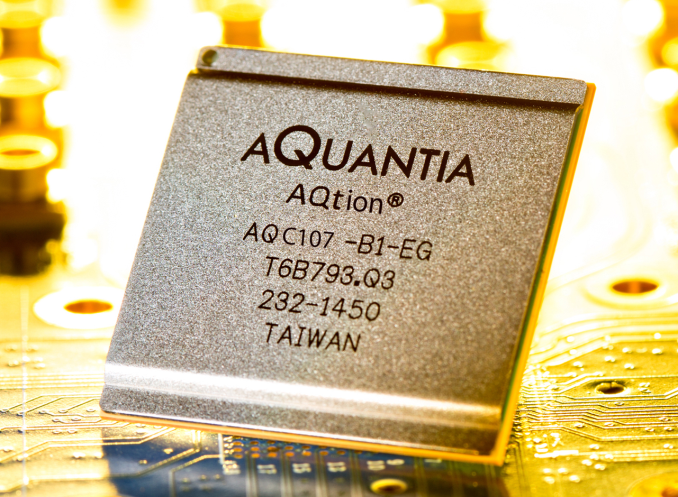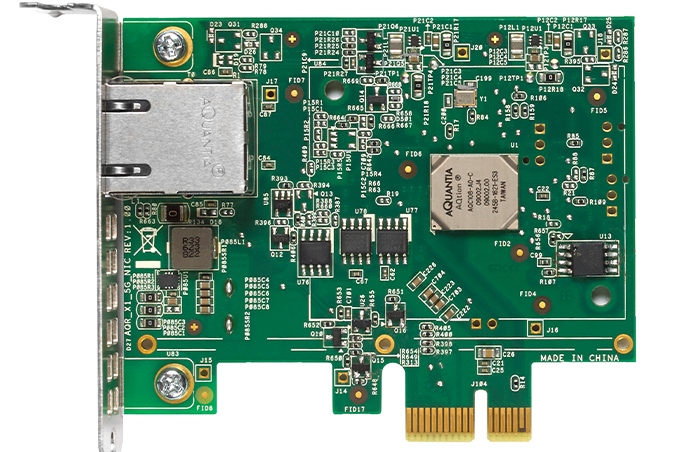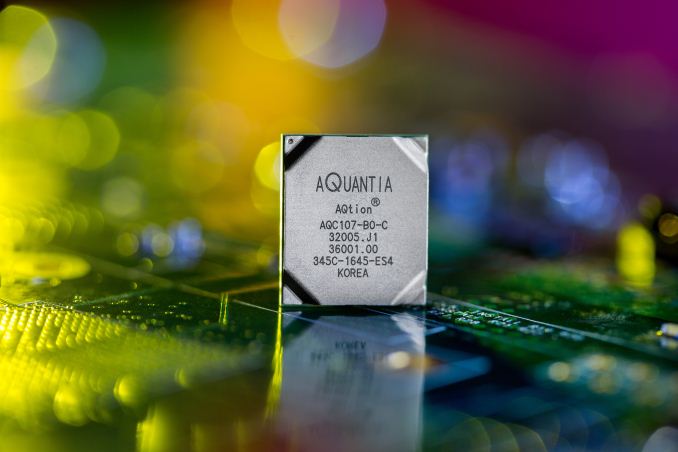Aquantia Launches New 2.5G/5G Multi-Gigabit Network Controllers for PCs
by Ian Cutress on December 14, 2016 2:00 PM EST- Posted in
- Motherboards
- Systems
- Networking
- Aquantia
- 2.5GBase-T
- 5GBase-T
- AQtion

Frequent readers of AnandTech will have recognized that our coverage of higher speed network interfaces over copper, particularly 10G, for the home and business has increased recently. This is perhaps no surprise: 1 Gbit speeds for wired networking have been the norm for fifteen years on consumer level products, but there are certainly some users that require faster network availability in their home/business due to the increased number of devices and size of content, particularly video content, that has exploded this decade.
Arguments aside about external network availability and infrastructure, streaming inside the home or in the office typically comes down to a couple of key factors – the size of the networking backbone and the capability of each device connected to it. For consumer infrastructure that stays on copper, 1Gbit or teamed connections has been the limit for long distance Cat 5a/Cat 6 cabling, which is fairly cheap, and some solutions have moved to the more expensive 10GBase-T solutions which are power hungry, more enterprise focused and simultaneously a lot more expensive by at least an order of magnitude. 10GBase-T also requires Cat 7 cabling for any serious distance requirements.
Back at the Supercomputing 2015 show, there were several talks about the utility of 2.5G and 5G copper networks. These discussions were primarily focused in the data-center and high-performance categories rather than the consumer, and at the time I commented that it was likely where these standards were to stay as it would require a significant step up to drive a 2.5x/5x adoption for the consumer over a 10x adoption. It was expected that the cost of 10G would start to come down, but over 2016 it has remained consistent, much to the chagrin of enthusiasts.
At the time in 2015, the 2.5G/5G standards were not yet ratified by IEEE. There were chips in the market, solely from Aquantia, for enterprise configurations that were happy to go with an evolving standard for their solution. From September 2016 this changed, and the standards have been ratified with Aquantia, Intel, Cisco and others all involved in the specification. Aquantia’s earlier generation silicon adhered to the standard, and has been deployed in a number of enterprise backbone deployments to the tune of 5M ports a year. Today’s announcement surrounds the launch of two new controllers based on the multi-gigabit standards aimed at more consumer level solutions – specifically ‘client connectivity in enterprise, gaming and SMB applications’.
The chips are small, 11x7mm, and use Aquantia’s expertise in both MAC/PHY management to produce the AQtion brand (as in, ‘Action’), to complement the AQrate (‘accurate’) currently in the ecosystem. The two AQtion controllers are single channel, single port solutions and differ in their speed support:
AQC107: 100M/1G/2.5G/5G/10G
AQC108: 100M/1G/2.5G/5G
The AQC107 will support 10GBase-T on Cat 6 copper cables, adhering to the 8 02.3an standard, although at a different set of distance limitations. Both chips are targeting a large market of motherboards, routers, office PCs, switches, routers, dongles and anything that a consumer or small/medium business might purchase. This includes add-in PCIe cards. Both chips will support up to PCIe 3.0 x4 connectivity, going down to PCIe 2.0 x1 as required (peak rates will be limited in this mode, obviously).
On price comparisons to current gigabit solutions, Aquantia was unwilling to release the information given that individual contracts will govern the price but they were willing to say that a number of partners are already in production of their hardware. Aquantia wanted to make it clear that they will leave it up to their partners to market and promote the feature set of the controller. This will become important, especially as the motherboard PC networking controller market has a number of options.
Currently the big players are Intel and Realtek, using the I219-V/LM and RTL8111E/F families respectively. Certain versions of the controllers have more management functions, or prioritize some capabilities over the others, and key defining elements are both cost and consumer requests (distributors or clients). Rivet Networks is also a significant player with their Killer brand of networking ICs, focusing primarily on the gaming crowd with controller specific QoS features that are promoted to gamers and prosumers, and used extensively with MSI laptops and MSI/Gigabyte motherboards. Technically Realtek has the Dragon brand here, although we’ve only seen them on one generation of ECS motherboards so far. It’s important to note that only the Killer ICs come with any form of default controller software aimed at consumers for QoS and traffic shaping; Intel has management software at a more admin level. We asked Aquantia about additional consumer software, and was told that currently none is bundled but they are aware of the current market.
For now, the AQtion 2.5G/5G controllers coming to market look to be a premium component, destined for high-end notebooks/PCs, and if the pricing is right, more expansive than the current array of 10G integrated options. One of the issues Aquantia will have, which they also acknowledge, is the switch problem that currently stops 10G being more widespread – the lack of consumer grade and consumer budget level switches. We were told that there are some enterprise models of 2.5G/5G switches currently for more backbone type of work, and it will be up to Aquantia’s partners to spot opportunities in the consumer market. From a personal perspective, the switch side of the equation will be the slowest to change and be a defining aspect for the widespread adoption of this technology. We’ve seen this with 10G, or the fact that the Killer gaming NICs do not have corresponding switches/routers to assist in a number of features that might become irrelevant in a general network. Publicly Aquantia isn’t stating which switch developers they are working with, and as before, leaving those companies to decide/announce their product lines, but I think the switch aspect will be more important to watch over 2017.
On performance metrics, Aquantia have told us that the AQ107 can achieve 9.5 Gbps in each direction in the 10G mode with a CPU utilization of 12-20%, and in 5G mode it can do 4.6 Gbps in each direction with 6-14% CPU use. Due to the higher clock rate of the controller, in 1G mode the controller is quoted as having has lower latency than standard 1G controllers. The AQC107, in 5G mode, will have a typical power consumption around 3W when in use.
We were told that the chips support Wake-on-LAN and Energy Efficient Ethernet standards for power saving (wake-up in the microsecond range), as well as various offloads for reducing CPU use (LSO, LRO, header checksum, receive side scaling). QoS features allow for 32 queues/traffic in each direction, as well as rate shaping capabilities. Drivers will be available for all major flavors of Windows (7 to 10, 32/64-bit), Linux and macOS.
Aquantia stated that they are using their deep contacts at TSMC and GloFo for their product range, but stopped short of stating which process or which node they are using. Behind the scenes we have already have a sniff of upcoming products using Aquantia’s solution that are due to be announced over the next few months.
Source: Aquantia












32 Comments
View All Comments
bcronce - Thursday, December 15, 2016 - link
They could include 10Gb if they really wanted. They already have a 14nm SoC Xeon 8core/16thread platform with an integrated 10Gb 5xx dual-port nic for less than $1k, and the entire system consumes around 40watts theoretical max. The nic is effectively free at that price and incredibly low power.The only reason it works for the SoC is because 14nm makes 10Gb trivial. The trouble is finding unused 14nm capacity to fab chipsets, no one wants to waste bleeding edge fabs for such low margin products.
Intel's high end NICs went from dual-port 10Gb @ (32nm 15watt $600) to quad-port 40Gb @ (28nm 8watt $400). Imagine going to 22nm or even 14nm.
Kamal Dalmia - Wednesday, December 14, 2016 - link
The new rates of 2.5G and 5G have already taken off in the enterprise networking for the purpose of connecting Switches to WiFi Access points. The enterprise products with these capabilities have been in the market since 1H of 2015. These new chips brings that capability to the SMB and Client space.This technology is being promoted by an group of companies under an organization called NBASE-T alliance. The products in the market are listed on their website. See www.nbaset.org
Kamal Dalmia - Aquantia
Gigaplex - Wednesday, December 14, 2016 - link
1Gbit is a bottleneck in my home network, and 10Gbit is too expensive and overkill. Wireless is also definitely not simpler, and is just not consistent. Especially in an apartment building like mine, which has Cat6 in the wall. 2.5Gbit would be a huge improvement for me.DanNeely - Wednesday, December 14, 2016 - link
Cat 5e/6 are good for 45/55 meters with 10G wired connections; which is good enough for most residential use, unless you're on a building owned network running out of a basement wiring closet you're probably capable of running 10G on your existing wiring. Outside of enterprise relatively few people actually need 100m cable runs.johnthacker - Thursday, December 15, 2016 - link
It should work, yes. However, wouldn't you like the piece of mind of a NIC that will fall back to 5G or 2.5G if the 10G connection isn't working or auto-sensing fails, rather than fall back to 1G? No one likes the experience of thinking that 50 m should be good enough and then having it not be.Samus - Wednesday, December 14, 2016 - link
Seriously, if I can use my existing CAT5e at 5Gbit, I'm sold. Currently teaming NIC's to get 2Gbit and it's plenty fast but definitely a pain in the ass, and only has that amount of throughput from two PC's that each have teaming going on.I guess it really comes down to price and availability. If I can buy a 5 port switch and a few NIC's for, say, $200, it's a no brainer investment.
phoenix_rizzen - Wednesday, December 14, 2016 - link
How do you connect an 802.11ac access point that can handle > 1 Gbps right now, with a media server in your home? None of the AC APs I've seen include 10G ports. 10G switches aren't exactly cheap. 10G ports aren't very prevalent in the consumer space.Even in education/business settings, 10G ports aren't cheap, or even plentiful. Nor is CAT6/7 cabling. But 802.11ac APs are.
Desktop-to-switch connections don't really need to be faster than 1 Gbps, although faster is always better. But AP-to-switch, switch-to-switch, and switch-to-server definitely needs to be faster than 1 Gbps, but 10G isn't always practical.
DanNeely - Wednesday, December 14, 2016 - link
The Cisco Aironet 3800 supports 2x2.6gbit wifi links and has a 10G uplink port. One vendor I found selling it wanted ~$1100. The Aruba Networks AP-335 has a similar wifi capability but is only backed by a 5G wired connection and sells for $1300. As with most enterprise grade hardware, if you have to ask where it can be found or how much it costs; you probably can't afford it.hechacker1 - Thursday, December 15, 2016 - link
We get a decent discount and get them for ~600 and have been deploying them everywhere. And yeah, we're future proofing by deploying 3800 switches which support PoE and 5G. It makes sense. 10G is regulated to the uplinks between switches and servers.BrokenCrayons - Thursday, December 15, 2016 - link
Brace yourself for one of those stupid automobile analogies. Though I usually decry them, I think that using one in this case will help make sense of the situation without tanking the discussion with unneeded anger and resentment.You've purchased a large boat. The boat is solely for recreation. Let's say you love to go fishing and had disposable income available so rather than saving it for some other purpose, you picked up a loan and bought your dream boat. Unfortunately, your car can't safely tow it because it's too large and heavy. So you do what any American would do and you purchase a pickup truck that's more than enough to pull your boat. In your mind, the truck was a necessity rather than a luxury. Unfortunately, you failed to realize it only became a necessity because you purchased a boat. Now you're encumbered with dealing with all of the things a truck needs thanks to your recreational boat.
Now let's break off and take a look at a "home media server" and put it into perspective. You have a device supplying a service to your house and you feel you need higher network bandwidth to make use of it. In other words, you can't tow your boat to the lake the way you want to tow it. In the end, the solution to your problem is pretty simple because the need for more than 1Gbit (suspect anyway since even multiple HD streams won't saturate a 1Gbit link nor will most mechanical hard drives and using solid state storage for a media server is...well, now you have a yacht instead of a boat) only exists because of an unnecessary media server in the home. My advice, save the money and the time by dumping that home IT administration responsibility because it's not needed to begin with and you'll be happier with the added simplicity it brings to your life.